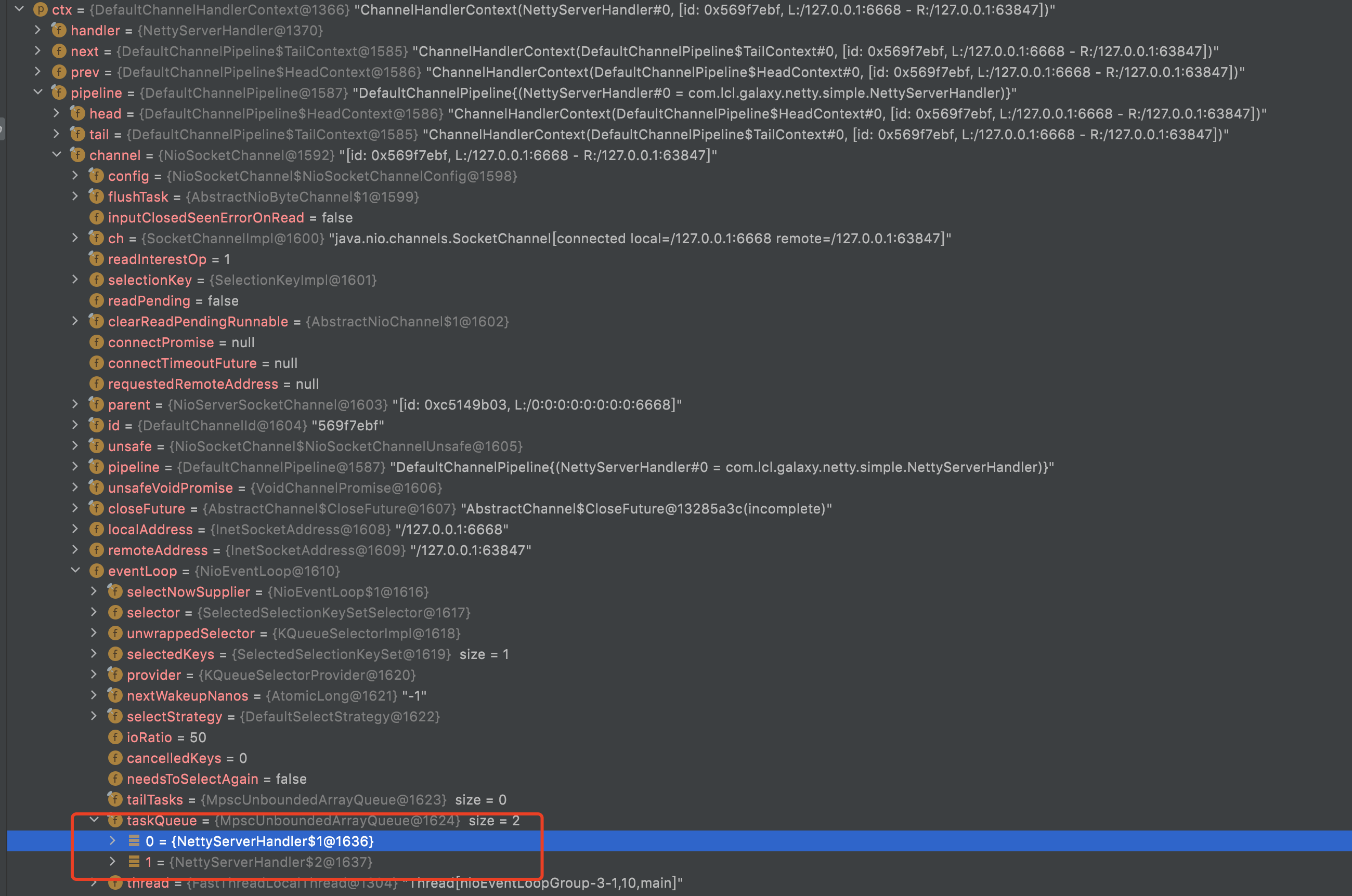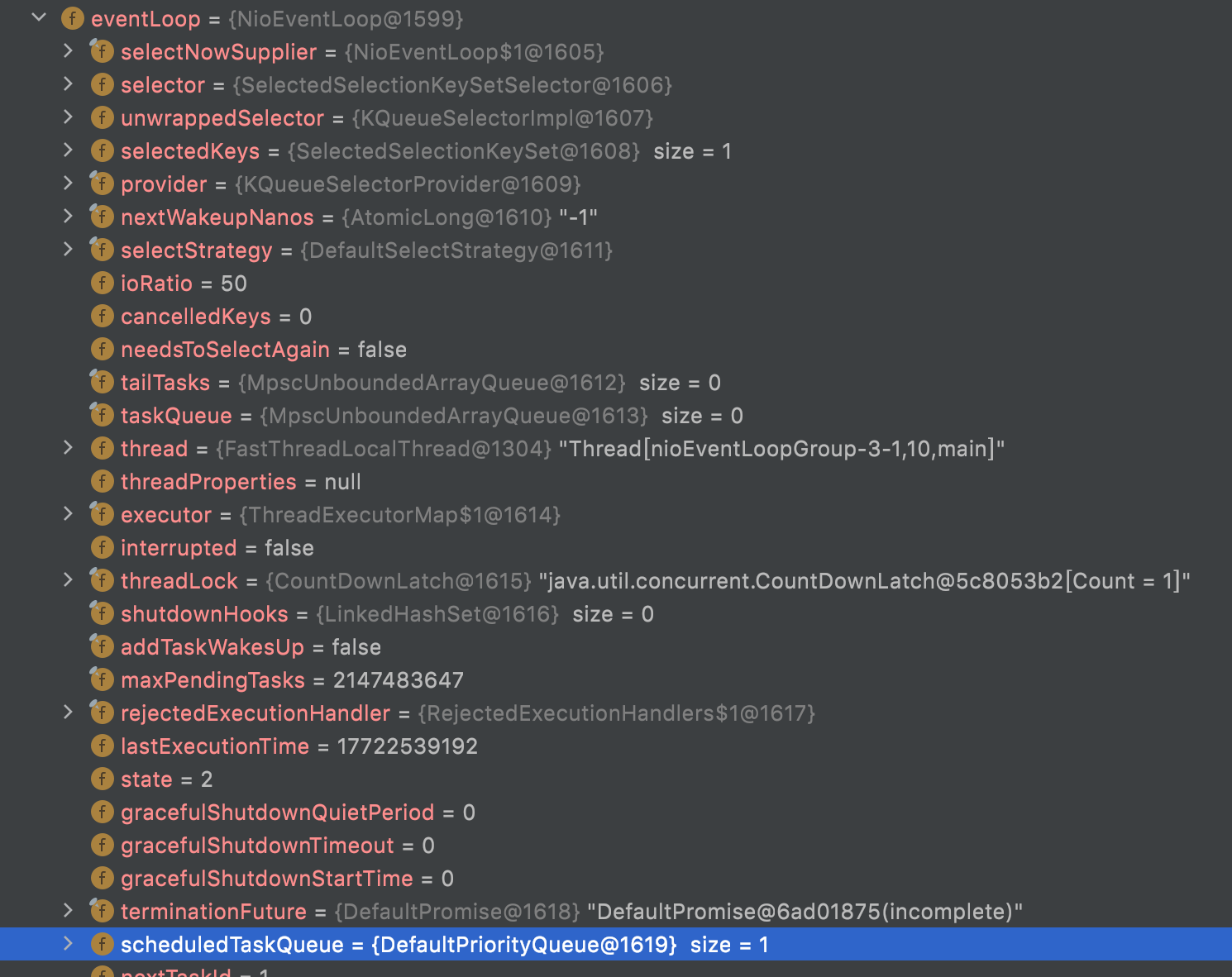Netty异步任务调度与异步线程池
一、异步任务调度
(一)为什么要使用异步任务调度
先写一个简单的Netty程序:
1、NettyServer
public class NettyServer { public static void main(String[] args) { //1. 创建两个线程组 bossGroup 和 workerGroup EventLoopGroup bossGroup = new NioEventLoopGroup(1); EventLoopGroup workerGroup = new NioEventLoopGroup(); //默认16try { //创建服务器端的启动对象,配置参数 ServerBootstrap bootstrap = new ServerBootstrap(); //使用链式编程来进行设置 bootstrap.group(bossGroup, workerGroup) //设置两个线程组 .channel(NioServerSocketChannel.class) //使用NioSocketChannel 作为服务器的通道实现 .option(ChannelOption.SO_BACKLOG, 128) // 设置线程队列得到连接个数 .childOption(ChannelOption.SO_KEEPALIVE, true) //设置保持活动连接状态 //.handler(null) // 该 handler对应 bossGroup , childHandler 对应 workerGroup .childHandler(new ChannelInitializer<SocketChannel>() {//创建一个通道初始化对象(匿名对象) //给pipeline 设置处理器 @Override protected void initChannel(SocketChannel ch) throws Exception { System.out.println("客户socketchannel hashcode=" + ch.hashCode()); //可以使用一个集合管理 SocketChannel, 再推送消息时,可以将业务加入到各个channel 对应的 NIOEventLoop 的 taskQueue 或者 scheduleTaskQueue ChannelPipeline pipeline = ch.pipeline(); pipeline.addLast(new NettyServerHandler()); } }); // 给workerGroup 的 EventLoop 对应的管道设置处理器 System.out.println("server is ready"); //绑定一个端口并且同步, 生成了一个 ChannelFuture 对象 //启动服务器(并绑定端口) ChannelFuture cf = bootstrap.bind(6668).sync(); //给cf 注册监听器,监控我们关心的事件 cf.addListener(new ChannelFutureListener() { @Override public void operationComplete(ChannelFuture future) throws Exception { if (cf.isSuccess()) { System.out.println("监听端口 6668 成功"); } else { System.out.println("监听端口 6668 失败"); } } }); cf.channel().closeFuture().sync(); } catch (InterruptedException e) { e.printStackTrace(); } finally { bossGroup.shutdownGracefully(); workerGroup.shutdownGracefully(); } } }
2、ServerHandler
public class NettyServerHandler extends ChannelInboundHandlerAdapter { private static final EventExecutorGroup group = new DefaultEventExecutorGroup(8); /** * 1. ChannelHandlerContext ctx:上下文对象, 含有 管道pipeline , 通道channel, 地址 * 2. Object msg: 就是客户端发送的数据 默认Object */ @Override public void channelRead(ChannelHandlerContext ctx, Object msg) throws Exception { System.out.println("channelReadThread:"+Thread.currentThread().getName()); ctx.writeAndFlush(Unpooled.copiedBuffer("hello, Client No 2 ", CharsetUtil.UTF_8)); System.out.println("go on ..."); } //数据读取完毕 @Override public void channelReadComplete(ChannelHandlerContext ctx) throws Exception { //writeAndFlush 是 write + flush //将数据写入到缓存,并刷新 //一般讲,我们对这个发送的数据进行编码 System.out.println("channelReadCompleteThread:"+Thread.currentThread().getName()); ctx.writeAndFlush(Unpooled.copiedBuffer("hello, Client No 1 ", CharsetUtil.UTF_8)); } //处理异常, 一般是需要关闭通道 @Override public void exceptionCaught(ChannelHandlerContext ctx, Throwable cause) throws Exception { ctx.close(); } }
3、NettyClient
public class NettyClient { public static void main(String[] args) { //客户端需要一个事件循环组 EventLoopGroup group = new NioEventLoopGroup(); //创建客户端启动对象 注意客户端使用的不是 ServerBootstrap 而是 Bootstrap Bootstrap bootstrap = new Bootstrap(); try{ //设置相关参数 bootstrap.group(group) //设置线程组 .channel(NioSocketChannel.class) // 设置客户端通道的实现类(反射) .handler(new ChannelInitializer<SocketChannel>() { @Override protected void initChannel(SocketChannel ch) throws Exception { ch.pipeline().addLast(new NettyClientHandler()); //加入自己的处理器 } }); System.out.println("client is ok.."); ChannelFuture channelFuture = bootstrap.connect("127.0.0.1", 6668).sync(); channelFuture.addListener(new ChannelFutureListener() { @Override public void operationComplete(ChannelFuture future) throws Exception { if (channelFuture.isSuccess()) { System.out.println("连接 6668 成功"); } else { System.out.println("连接 6668 失败"); } } }); //给关闭通道进行监听 channelFuture.channel().closeFuture().sync(); } catch (InterruptedException e) { e.printStackTrace(); } finally { group.shutdownGracefully(); } } }
4、clientHandler
public class NettyClientHandler extends ChannelInboundHandlerAdapter { //当通道就绪就会触发该方法 @Override public void channelActive(ChannelHandlerContext ctx) throws Exception { System.out.println("client " + ctx); ctx.writeAndFlush(Unpooled.copiedBuffer("hello, server: miaomiao", CharsetUtil.UTF_8)); } //当通道有读取事件时,会触发 @Override public void channelRead(ChannelHandlerContext ctx, Object msg) throws Exception { ByteBuf buf = (ByteBuf) msg; System.out.println("response:" + buf.toString(CharsetUtil.UTF_8)); } @Override public void exceptionCaught(ChannelHandlerContext ctx, Throwable cause) throws Exception { cause.printStackTrace(); ctx.close(); } }
上面的例子非常简单,就是启动NettyClient后向NettyServer写入信息,NettyServer在接收到信息后,在向NettyClient写入消息,分别在channelRead和channelReadComplete写入了两条信息,NettyClient执行的结果为:
response:hello, Client No 2 hello, Client No 1
但是这样就会存在一个问题,如果ServerHandler中channelRead中处理的是一个比较耗时的操作,例如与数据库交互等内容,那么就会阻塞相应,下面的代码就是模拟这种情况,代码也非常简单,就是向客户端写入数据前先休眠10秒钟。
@Override public void channelRead(ChannelHandlerContext ctx, Object msg) throws Exception { Thread.sleep(10 * 1000); ctx.writeAndFlush(Unpooled.copiedBuffer(System.currentTimeMillis() + "hello, Client No 2 ", CharsetUtil.UTF_8)); System.out.println(System.currentTimeMillis() + "go on ..."); }
上面代码的最终执行结果就是,需要等待十秒,服务端才会输出go on,同样的,客户端也需要等待十秒,才能拿到响应结果(channelRead的结果和channelComplete的结果)
那么如何解决这个问题呢,这里有两种结局方案:使用自定义任务提交到TaskQueue中,或者使用自定义的定时任务提交到scheduleTaskQueue中。
(二)TaskQueue
1、使用方法如下所示:
public void channelRead(ChannelHandlerContext ctx, Object msg) throws Exception { System.out.println("channelReadThread:"+Thread.currentThread().getName());// 解决方案1 用户程序自定义的普通任务 ctx.channel().eventLoop().execute(new Runnable() { @Override public void run() { try { Thread.sleep(10 * 1000); System.out.println("eventLoop().execute Thread1:"+Thread.currentThread().getName()); //请求讲当前的msg 通过ChannelPipeline 写入数据到目标Channel 中。值得注意的是:write 操作只是将消息存入到消息发送环形数组中,并没有真正被发送,只有调用flush 操作才会被写入到Channel 中,发送给对方。 ctx.writeAndFlush(Unpooled.copiedBuffer("hello, Client No 2 ", CharsetUtil.UTF_8)); System.out.println("Client No 2 success,"+Thread.currentThread().getName()); } catch (Exception ex) { System.out.println("发生异常" + ex.getMessage()); } } }); ctx.channel().eventLoop().execute(new Runnable() { @Override public void run() { try { Thread.sleep(5 * 1000); System.out.println("eventLoop().execute Thread2:"+Thread.currentThread().getName()); //请求讲当前的msg 通过ChannelPipeline 写入数据到目标Channel 中。值得注意的是:write 操作只是将消息存入到消息发送环形数组中,并没有真正被发送,只有调用flush 操作才会被写入到Channel 中,发送给对方。 ctx.writeAndFlush(Unpooled.copiedBuffer("hello, Client No 3 ", CharsetUtil.UTF_8)); System.out.println("Client No 3 success,"+Thread.currentThread().getName()); } catch (Exception ex) { System.out.println("发生异常" + ex.getMessage()); } } }); System.out.println(System.currentTimeMillis() + "go on ..."); }
上述代码中,手动向taskQueue中添加了两个任务,这样的话,go on就会先输出,Server不会阻塞。
上面的代码添加了两个任务,一个休眠了10秒,一个休眠了5秒,视为了验证在TaskQueue中的任务是串行执行的。在客户端的输出加上日期后,可以看到输出结果如下所示,也就验证了在TaskQueue中的任务是串行执行的。
response:2021-09-13T06:08:35.899hello, Client No 2 response:2021-09-13T06:08:40.850hello, Client No 3 response:2021-09-13T06:08:40.850hello, Client No 1
从代码的debug中也可以看到,这两个任务是提交到了ctx.pipeline.channel.eventloop.taskQueue中。

服务端的输出结果为:
channelReadThread:nioEventLoopGroup-3-1 1631499116759go on ... channelReadCompleteThread:nioEventLoopGroup-3-1 eventLoop().execute Thread1:nioEventLoopGroup-3-1 Client No 2 success,nioEventLoopGroup-3-1 eventLoop().execute Thread2:nioEventLoopGroup-3-1 Client No 3 success,nioEventLoopGroup-3-1
可以看到,无论是channelRead中单起的线程还是channelRead、channelReadComplete中的IO线程,使用的都是同一个线程。
(三)scheduleTaskQueue
第二种解决方案就是使用自定义的定时任务提交到scheduleTaskQueue中,实现如下所示:
@Override public void channelRead(ChannelHandlerContext ctx, Object msg) throws Exception { System.out.println("channelReadThread:"+Thread.currentThread().getName()); //解决方案2 : 用户自定义定时任务 -》 该任务是提交到 scheduleTaskQueue中 ctx.channel().eventLoop().schedule(new Runnable() { @Override public void run() { try { Thread.sleep(5 * 1000); System.out.println("channelReadThread3:"+Thread.currentThread().getName()); ctx.writeAndFlush(Unpooled.copiedBuffer("hello, Client No 4", CharsetUtil.UTF_8)); System.out.println("channel code=" + ctx.channel().hashCode()); } catch (Exception ex) { System.out.println("发生异常" + ex.getMessage()); } } }, 5, TimeUnit.SECONDS); System.out.println(System.currentTimeMillis() + "go on ..."); }
最终的输出结果如下所示
response:2021-09-13T06:34:34.791hello, Client No 1 response:2021-09-13T06:34:44.724hello, Client No 4
可以看到,其是延迟了5秒执行的,然后又阻塞了5秒,最终才输出,但是从输出的结果看,channelReadComplete不再依赖这个的结果,直接进行了返回。
同时从debug的结果看,任务是被提交到了ctx.pipeline.channel.eventloop.scheduleTaskQueue中

服务端的输出结果如下所示:
channelReadThread:nioEventLoopGroup-3-1 1631499905539go on ... channelReadCompleteThread:nioEventLoopGroup-3-1 channelReadThread3:nioEventLoopGroup-3-1 channel code=1068232496
可以看到,和taskQueue一样,定时任务的线程和IO线程使用的是同一个线程。
(四)向其它线程调度任务
在Netty的使用中,我们不仅可以对当前的客户端写入数据,同时也可以对其他的客户端写入数据,就以群聊为例(完整代码可以参照:Netty编码示例)
使用方法就是使用一个ChannelGroup,在客户端链接时添加,在客户端离线时移除,在需要对所有客户端写入数据时,循环ChannelGroup中的ChannelHandlerContext即可。
public class GroupChatServerHandler extends SimpleChannelInboundHandler<String> {//handlerAdded 表示连接建立,一旦连接,第一个被执行 //将当前channel 加入到 channelGroup @Override public void handlerAdded(ChannelHandlerContext ctx) throws Exception { Channel channel = ctx.channel(); channelGroup.writeAndFlush("[客户端]" + channel.remoteAddress() + " 加入聊天" + sdf.format(new java.util.Date()) + " \n"); channelGroup.add(channel); } //断开连接, 将xx客户离开信息推送给当前在线的客户 @Override public void handlerRemoved(ChannelHandlerContext ctx) throws Exception { Channel channel = ctx.channel(); channelGroup.writeAndFlush("[客户端]" + channel.remoteAddress() + " 离开了\n"); System.out.println("channelGroup size=" + channelGroup.size()); }//读取数据 @Override protected void channelRead0(ChannelHandlerContext ctx, String msg) throws Exception { //获取到当前channel Channel channel = ctx.channel(); //这时我们遍历channelGroup, 根据不同的情况,回送不同的消息 channelGroup.forEach(ch -> { if (channel != ch) { //不是当前的channel,转发消息 ch.writeAndFlush("[客户]" + channel.remoteAddress() + " 发送了消息" + msg + "\n"); } else {//回显自己发送的消息给自己 ch.writeAndFlush("[自己]发送了消息" + msg + "\n"); } }); } }
(五)异步任务调度总结
1、TaskQueue如何使用
(1)⾃定义任务 : ⾃⼰开发的任务 , 然后将该任务提交到任务队列中 ;
(2)⾃定义定时任务 : ⾃⼰开发的任务 , 然后将该任务提交到任务队列中 , 同时可以指定任务的执⾏时间 ;
(3)其它线程调度任务
2、Handler同步异步
⽤户⾃定义的 Handler 处理器 , 该处理器继承了 ChannelInboundHandlerAdapter 类 , 在重写的public void channelRead(ChannelHandlerContext ctx, Object msg) throws Exception ⽅法中 , 执⾏的业务逻辑要注意以下两点 :
同步操作 : 如果在该业务逻辑中只执⾏⼀个短时间的操作 , 那么可以直接执⾏ ;
异步操作 : 如果在该业务逻辑中执⾏访问数据库 , 访问⽹络 , 读写本地⽂件 , 执⾏⼀系列复杂计算等耗时操作 , 肯定不能在该⽅法中处理 , 这样会阻塞整个线程 ; 正确的做法是将耗时的操作放⼊任务队列 TaskQueue , 异步执⾏ ;
3、⾃定义任务的执行顺序
如果⽤户连续向任务队列中放⼊了多个任务 , NioEventLoop 会按照顺序先后执⾏这些任务 , 注意任务队列中的任务 是先后执⾏ , 不是同时执⾏ ;
顺序执⾏任务 ( 不是并发 ) : 任务队列任务执⾏机制是顺序执⾏的 ; 先执⾏第⼀个 , 执⾏完毕后 , 从任务队列中获取第⼆个任务 , 执⾏完毕之后 , 依次从任务队列中取出任务执⾏ , 前⼀个任务执⾏完毕后 ,才从任务队列中取出下⼀个任务执⾏ ;
4、⾃定义任何和自定义定时任务
⽤户⾃定义定时任务 与 ⽤户⾃定义任务流程基本类似:
(1)调度⽅法 :
定时异步任务使⽤ schedule ⽅法进⾏调度
普通异步任务使⽤ execute ⽅法进⾏调度
(2)任务队列 :
定时异步任务提交到 ScheduleTaskQueue 任务队列中 ;
普通异步任务提交到 TaskQueue 任务队列中 ;
5、向其它线程调度任务
在服务器中使⽤ Map 集合管理该 Channel 通道 , 需要时根据⽤户标识信息 , 获取该通道 , 向该客户端通道对应的 NioEventLoop 线程中调度任务 ;
二、异步线程池
上面提到了使用异步任务调度所使用的的线程仍然是和IO操作是同一个线程,因此如果做的是比较耗时的工作或不可预料的操作,⽐如数据库,⽹络请求,会严重影响 Netty 对 Socket 的处理速度。⽽解决⽅法就是将耗时任务添加到异步线程池中。
但就添加线程池这步操作来讲,可以有2种⽅式:
handler 中加⼊线程池
Context 中添加线程池
(一)handler 中加⼊线程池
1、如何使用
使用方法比较简单,就是创建了一个EventExecutorGroup,并向其中提交任务。
private static final EventExecutorGroup group = new DefaultEventExecutorGroup(8); @Override public void channelRead(ChannelHandlerContext ctx, Object msg) throws Exception { System.out.println("channelReadThread:"+Thread.currentThread().getName()); ctx.writeAndFlush(Unpooled.copiedBuffer(System.currentTimeMillis() + "hello, Client No 2 ", CharsetUtil.UTF_8)); group.submit(new Runnable() { @Override public void run() { System.out.println("groupThread:"+Thread.currentThread().getName()); ctx.writeAndFlush(Unpooled.copiedBuffer("hello, Client No 2 ", CharsetUtil.UTF_8)); } }); System.out.println("go on ..."); }
启动两个Client,Server输出结果:
channelReadThread:nioEventLoopGroup-3-1 go on ... channelReadCompleteThread:nioEventLoopGroup-3-1 groupThread:defaultEventExecutorGroup-5-1 客户socketchannel hashcode=1589534751 channelReadThread:nioEventLoopGroup-3-2 go on ... channelReadCompleteThread:nioEventLoopGroup-3-2 groupThread:defaultEventExecutorGroup-5-2
可以看到,这样就是用了与IO操作不同的线程来处理业务逻辑。并且每个客户端的请求使用的都是不同的线程。
2、源码
源码部分主要就是在write方法中,可以看到,其判断了提交的异步执行任务是否是一个EventLoop事件,如果是,做后续的判断处理,如果不是,则创建一个新的线程执行。
这里走的是后一种逻辑,直接创建了一个新的线程池。
abstract class AbstractChannelHandlerContext implements ChannelHandlerContext, ResourceLeakHint { .... private void write(Object msg, boolean flush, ChannelPromise promise) { ObjectUtil.checkNotNull(msg, "msg"); try { if (this.isNotValidPromise(promise, true)) { ReferenceCountUtil.release(msg); return; } } catch (RuntimeException var8) { ReferenceCountUtil.release(msg); throw var8; } AbstractChannelHandlerContext next = this.findContextOutbound(flush ? 98304 : '耀'); Object m = this.pipeline.touch(msg, next); EventExecutor executor = next.executor(); if (executor.inEventLoop()) { if (flush) { next.invokeWriteAndFlush(m, promise); } else { next.invokeWrite(m, promise); } } else { AbstractChannelHandlerContext.WriteTask task = AbstractChannelHandlerContext.WriteTask.newInstance(next, m, promise, flush); if (!safeExecute(executor, task, promise, m, !flush)) { task.cancel(); } } } }
(二)Context中添加线程池
在调⽤addLast⽅法添加线程池后,handler将优先使⽤这个线程池,如果不添加,将使⽤IO线程。
private static final EventExecutorGroup group =new DefaultEventExecutorGroup(2); pipeline.addLast(group,new NettyServerHandler());
输出结果
channelReadThread:defaultEventExecutorGroup-4-1 go on ... channelReadCompleteThread:defaultEventExecutorGroup-4-1 客户socketchannel hashcode=-678377054 channelReadThread:defaultEventExecutorGroup-4-2 go on ... channelReadCompleteThread:defaultEventExecutorGroup-4-2
(三)两者对比
在handler中添加异步,可能更加的⾃由,⽐如如果需要访问数据库,那我就异步,如果不需要就不异步,异步会拖⻓接⼝响应时间。因为需要将任务放进task中,如果IO时间很短,task很多,可能⼀个循环下来,都没时间执⾏整个task,导致响应时间不达标。
Context中添加线程池⽅式是Netty标准⽅式即加⼊到队列,但是这么做会将整个handler都交给业务线程池,不论耗时不耗时都加⼊队列,不够灵活。
-----------------------------------------------------------
---------------------------------------------
朦胧的夜 留笔~~






【推荐】国内首个AI IDE,深度理解中文开发场景,立即下载体验Trae
【推荐】编程新体验,更懂你的AI,立即体验豆包MarsCode编程助手
【推荐】抖音旗下AI助手豆包,你的智能百科全书,全免费不限次数
【推荐】轻量又高性能的 SSH 工具 IShell:AI 加持,快人一步
· AI与.NET技术实操系列:向量存储与相似性搜索在 .NET 中的实现
· 基于Microsoft.Extensions.AI核心库实现RAG应用
· Linux系列:如何用heaptrack跟踪.NET程序的非托管内存泄露
· 开发者必知的日志记录最佳实践
· SQL Server 2025 AI相关能力初探
· 震惊!C++程序真的从main开始吗?99%的程序员都答错了
· 【硬核科普】Trae如何「偷看」你的代码?零基础破解AI编程运行原理
· 单元测试从入门到精通
· 上周热点回顾(3.3-3.9)
· winform 绘制太阳,地球,月球 运作规律